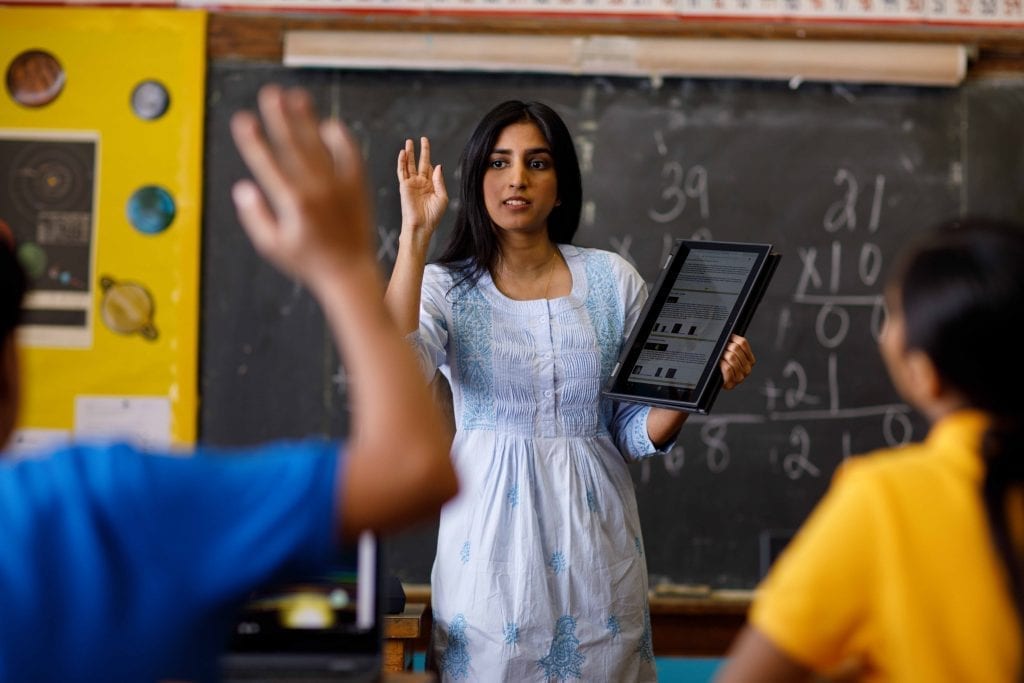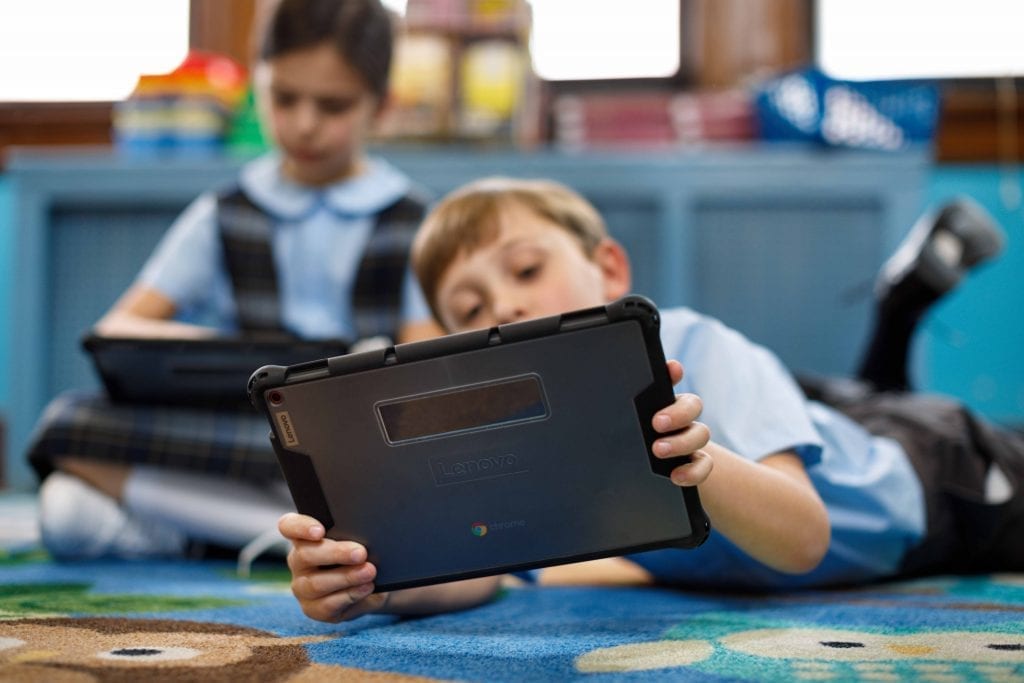At Lenovo, we recognize that educational continuity can have different meanings depending on your role in education. But for many children, continuity means school.
Covid-19 has caused unprecedented disruption to educational systems worldwide with the near-total closures of schools, universities and colleges. As remote schooling has become the main model for education delivery during this pandemic, teachers and education leaders have needed to adapt and juggle challenging and competing demands to ensure the best outcomes for pupils.
Since March 2020, the number of students around the world whose educational experience has been impacted by the pandemic has increased at an alarming rate. At the height of the crisis, over 1.5 Billion learners were affected by school closures. According to UNICEF, the pandemic is affecting more primary learners than any other group, and these are the students who need the most support when it comes to remote learning. Some countries have started to reopen their schools’ doors. However, much work still needs to be done to address the academic time lost and the social and emotional impact caused by the rapid shift to remote learning.
Despite the setbacks due to Covid-19, teachers, instructional leaders and higher education have innovated at an accelerated pace in an effort to provide students and families with educational continuity. Whether learning is happening remotely; in a hybrid environment; or in-person; educators have risen to the challenges they and their students have faced.

The following examples of stories from the UK, Italy and the United States, where Lenovo is proud to have been able to provide support or solutions, reflect the relentless determination of teaching staff to meet the needs of every student, every day.
Remote learning in the UK – a typical day
To better understand how to support the transition to remote learning, Lenovo spoke with UK teachers last spring about their experiences of staying connected to and engaging with students during the lockdown. We heard from Joss, a geography teacher, Gareth a year six teacher in Surrey, and Elly, a year one teacher in Oxford.
Joss: “ If I walk you through my day now and what that would look like in school, it’s very similar to what it was before lockdown, but also really, really different. At 08:30, I register my boys. I use a Chromebook and we have a Google Meet where we have a little video chat which is a great chance to check in with them pastorally. Also to make sure that they’re up, and ready to learn.”
Gareth: “ At the moment we’re using a mixture of websites. What happens is the children login in the mornings. They find personalized To Dos, which they can work through at their own speed and at their own rate.”
Elly: “I’m no longer in the classroom teaching my class, but teaching at home through a computer –– relying on technology to connect us. Technology is amazing! And is really allowing us to support children in ways I don’t think we’d be able to without. Video conferencing and video calls have become the new norm. I think it’s really important with devices that you have a good quality camera for these video calls so you’re not staring at a pixelated blob on your screen.”
These will be familiar scenarios for teachers and educators the world over who have had to adjust their teaching practices, but what about those communities with under resourced schools? How have they ensured students have devices and Wi-Fi access so they can continue to learn while locked down?

Bridging the digital divide in Italy
When schools began to close their doors in Milan, the mayor, Giuseppe Sala, sought support in the delivery of an efficient digital learning system. Recognizing this was a community crisis, he asked businesses and organizations to “donate materials and e-learning tools to schools, so that children who do not have access to devices can follow their lessons with their peers.” In response, Lenovo, in partnership with Microsoft, was able to provide Milan and the town of Vo’ with 190 laptop computers, helping to address the digital divide. The pandemic also led educators in Milan to re-think the educational relationship between families and schools that further supports learning.
“A school is not just a building but, above all, a community created by teachers and students in partnership with families. We’ve discovered that schooling can be provided in new ways and in new spaces, but everyone needs to be on the same page.” ~ Laura Galimberti, Milan’s Councillor for Education
Patrizia Forcato, Administrative Manager at one of the schools shared that this initiative is an example of real synergy between the school, the families, the social services departments of the local municipalities and the business world.
At Lenovo, we realize the importance of educational continuity – not only because it allows for a more seamless learning experience, but also because it keeps classroom communities connected. According to research, students’ connection with their teachers is one of the key determiners of academic success, which makes robust technology critical to the remote and hybrid learning experience.
Randolph Eastern School Corporation – Union City, Indiana
In the United States, teachers in an Indiana school district were focused on remote learning before it became a necessity, and leveraged that experience to engage with their students during the pandemic.
For the past few years, Randolph Eastern School Corporation in Union City, Indiana had been implementing a distance learning program to support education continuity in the event of inclement weather and to provide teachers time for professional development. Teachers and students were using Lenovo’s LanSchool Air, a cloud-based classroom management software, to effectively support, manage, and maintain student engagement. When schools closed in the spring due to the pandemic, teachers were able to continue using LanSchool Air with frequent class meetups in Google Hangouts to not only provide instructional continuity, but also maintain communication with their most vulnerable students.
“I’ve been able to keep up with kids I definitely would have lost without LanSchool Air. Some kids just are never as engaged, but with remote learning, it’s important to make themselves present.”
~ Karli Bransteter, 7th and 8th Grade Science Teacher, Union.
With LanSchool Air teachers can view students’ computer screens, seamlessly send websites to students, and group them by interest or academic need. Students can also engage with their teacher using the raise hand feature as well as stay connected, in and out of class, via interactive chat.
Flexible learning – catering to different needs and learning styles
Roma Tre University is a young and rapidly growing institution which has created flexible learning environments during the pandemic. Due to Covid-19, the university had to reduce the number of seats per classroom by 50%, leading to the implementation of hybrid learning. The university’s Telecommunications Manager, Paolo Cursi and his team worked closely with Lenovo to transform 220 classrooms with our Hybrid Classroom solution — the ThinkSmart Hub 500 Microsoft Teams Room System. The solution brings together robust audio, two cameras and collaborative software into a single solution to create a flexible learning space. This allows all students to have equitable access and a seamless experience whether they are learning inside or outside the classroom.
The response has been overwhelmingly positive. The most appreciated features are that lessons are recorded for access anytime, anywhere; students and professors from across the globe can connect; and students can actively collaborate during class whether they are at home or on campus.
“An easy experience of the lightness of chalk and the power of cloud joined together in a classroom without walls.” ~ Alessandro Neri, Professor, Telecommunications Engineering
“Lessons are richer in the classroom, and at home you can participate easily without losing any of the interaction with teachers and students.” ~ Teresa, Student, Second Year
The innovation accelerator – a changing education imperative
Major world events are often an inflection point for rapid innovation. The Covid-19 pandemic has most certainly disrupted education systems across the world but has also accelerated the next phase of innovative education with e-learning front and center in the ‘new normal’.
At Lenovo, we’ve been privileged to support educators as they challenge themselves every day to reimagine and reinvent teaching and learning during the pandemic – individuals who have worked tirelessly to bridge the digital divide, provide equitable learning environments, and address education continuity. We thank all those who have been willing to share their stories with Lenovo and we look forward to continuing our support and playing our part in aiding future innovation.
